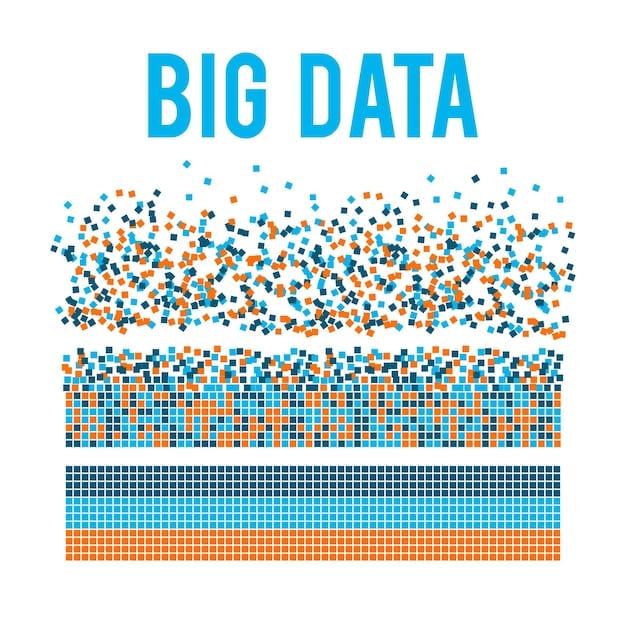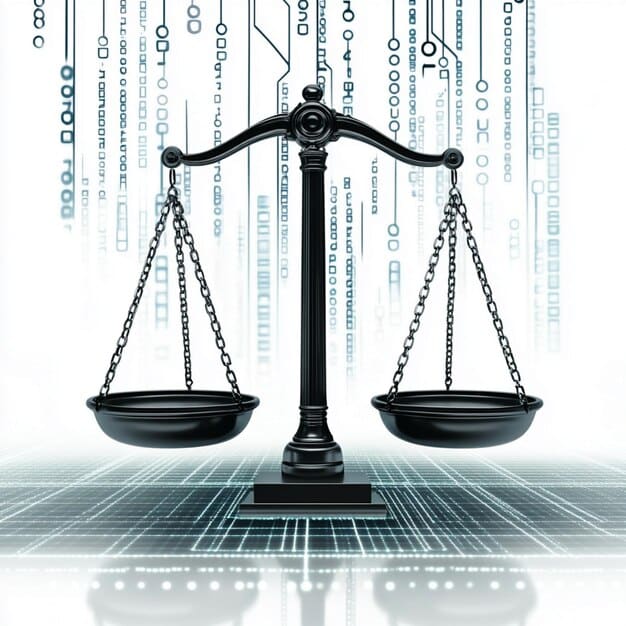Debating AI Ethics: Ensuring Fairness and Preventing Bias in AI Systems

Debating the Ethics of Artificial Intelligence: How Can We Ensure AI Systems are Free from Bias and Discrimination? involves critical examination of algorithms, data, and deployment strategies to mitigate unfair outcomes. Addressing bias demands interdisciplinary collaboration and continuous evaluation of AI’s impact on society.
Artificial intelligence is rapidly transforming various aspects of our lives, from healthcare to finance. However, the increasing reliance on AI systems raises significant ethical concerns. A critical issue is debating the ethics of artificial intelligence: how can we ensure AI systems are free from bias and discrimination? Failing to address these concerns can lead to unfair or discriminatory outcomes, perpetuating existing societal inequalities. This article delves into the complexities of debating the ethics of artificial intelligence and explores practical strategies for creating fairer, more equitable AI systems.
Understanding Bias in AI: Where Does It Come From?
Bias in AI systems doesn’t appear out of thin air. Rather, it is often baked into the very fabric of the algorithms and data used to train them. Recognizing the sources of bias is a crucial first step in debating the ethics of artificial intelligence: how can we ensure AI systems are free from bias and discrimination?
Data Bias: A Reflection of Imperfect Realities
One of the primary sources of bias is the data used to train AI models. If the training data reflects existing societal biases, the AI system will likely perpetuate and even amplify these biases. For example, if a facial recognition system is primarily trained on images of one ethnicity, it may perform poorly on individuals from other ethnic groups.
- Historical biases present in the data.
- Underrepresentation of certain groups.
- Skewed data collection methodologies.
To tackle data bias effectively, datasets need to be carefully curated, diverse, and representative of the populations they are intended to serve. This may require actively seeking out and incorporating data from underrepresented groups and continuously auditing datasets for potential sources of bias.

Algorithmic Bias: The Code Isn’t Neutral
Algorithmic bias arises from the design and implementation of AI algorithms themselves. The choices made by developers, such as the selection of features and the structure of the model, can inadvertently introduce bias into the system. Even seemingly neutral algorithms can produce biased outcomes when applied to biased data.
Careful attention must be given to algorithm design and evaluation to minimize the risk of bias. This includes using fairness-aware algorithms, employing techniques for detecting and mitigating bias, and conducting thorough testing on diverse datasets. Transparency in algorithmic design is also key to ensuring accountability and fostering trust.
Understanding the origins of bias is fundamental when debating the ethics of artificial intelligence: how can we ensure AI systems are free from bias and discrimination? Recognizing these sources allows us to strategically address them. By taking a proactive stance, developers and policymakers can pave the way for fairer AI systems.
The Impact of Biased AI: Real-World Consequences
The implications of biased AI systems are far-reaching, affecting critical areas such as healthcare, criminal justice, and employment. Recognizing the potential harm caused by these biases is essential for debating the ethics of artificial intelligence: how can we ensure AI systems are free from bias and discrimination?
Healthcare: Disparities in Treatment
AI is increasingly used in healthcare for tasks such as diagnosis, treatment planning, and drug discovery. However, biased AI systems can exacerbate existing health disparities. For instance, if AI models used to predict patient risk are trained on data that disproportionately represents certain demographic groups, they may provide inaccurate or unfair assessments for other groups.
- Inaccurate diagnoses leading to improper treatment.
- Unequal access to advanced medical care.
- Exacerbation of existing health disparities.
Addressing bias in healthcare AI requires diverse and representative datasets, fairness-aware algorithms, and ongoing monitoring to ensure equitable outcomes for all patients. Ethical oversight and collaboration among AI developers, healthcare providers, and policymakers are crucial for deploying AI responsibly in healthcare.
Criminal Justice: Perpetuating Inequities
AI is used in various aspects of the criminal justice system, including risk assessment, predictive policing, and sentencing. Biased AI systems can perpetuate and amplify existing racial and socioeconomic disparities, leading to unfair or discriminatory outcomes.
For instance, risk assessment tools used to predict the likelihood of recidivism have been shown to be biased against certain racial groups, with potentially devastating consequences for individuals and communities. It’s crucial when we’re debating the ethics of artificial intelligence: how can we ensure AI systems are free from bias and discrimination? in this very important area.

Mitigating bias in criminal justice AI requires transparency, accountability, and fairness-aware algorithms. It also requires careful consideration of the social and ethical implications of using AI in high-stakes decisions that can affect individuals’ lives and liberties.
The consequences of biased AI systems are real and impactful. Recognizing the potential for harm is a fundamental aspect of debating the ethics of artificial intelligence: how can we ensure AI systems are free from bias and discrimination? Developing ethical frameworks for AI is crucial to mitigate these adverse effects.
Strategies for Mitigating Bias: A Proactive Approach
Mitigating bias in AI requires a multifaceted approach that spans the entire AI development lifecycle, from data collection to deployment. Embracing these strategies is fundamental to debating the ethics of artificial intelligence: how can we ensure AI systems are free from bias and discrimination?
Data Diversity and Augmentation
Ensuring that AI models are trained on diverse and representative datasets is essential for reducing bias. This may require actively seeking out and incorporating data from underrepresented groups. It also involves careful data cleaning and preprocessing to mitigate the impact of missing or inconsistent data.
Data augmentation techniques can be used to artificially increase the size and diversity of the training dataset. This involves generating new data points by applying transformations to existing data, such as rotations, translations, and noise addition.
Fairness-Aware Algorithms
Traditional machine learning algorithms often optimize for accuracy without regard for fairness. Fairness-aware algorithms, on the other hand, explicitly incorporate fairness constraints into the learning process. These algorithms can be designed to minimize disparate impact, ensure equal opportunity, or satisfy other fairness criteria.
Auditing and Monitoring: Continuous Vigilance
Regular auditing and monitoring of AI systems are crucial for detecting and mitigating bias. This involves evaluating the performance of the system on diverse subgroups and identifying any disparities in outcomes. Auditing can also help detect unintended consequences and unanticipated sources of bias.
- Ongoing monitoring to track performance across demographic groups.
- Regular auditing to identify emerging biases or unintended consequences.
- Feedback loops to incorporate user input and adapt to changing social contexts.
The implementation of monitoring and auditing practices allows for continuous improvement in the quest of debating the ethics of artificial intelligence: how can we ensure AI systems are free from bias and discrimination? and reducing discriminatory outcomes.
Adopting a proactive approach to mitigating bias is essential for creating fairer and more equitable AI systems. By embracing these strategies, developers and policymakers can pave the way for a future where AI benefits all members of society.
Ethical Frameworks and Guidelines: Steering AI Development
Establishing ethical frameworks and guidelines is crucial for guiding the responsible development and deployment of AI systems. These frameworks provide a set of principles and values to inform decision-making and ensure that AI is used in a way that aligns with societal values.
Transparency and Accountability
Transparency and accountability are fundamental principles of ethical AI development. Transparency involves making AI systems more understandable and explainable, so that users can understand how decisions are made. Accountability involves establishing clear lines of responsibility for the design, development, and deployment of AI systems.
Implementing AI systems that are transparent and accountable encourages confidence, allowing for better debating the ethics of artificial intelligence: how can we ensure AI systems are free from bias and discrimination? These factors are essential for building trust in AI technology.
Human Oversight and Control
Human oversight and control are essential safeguards against bias and unintended consequences. AI systems should be designed to augment human decision-making, not replace it entirely. Humans should retain the ability to override or modify AI decisions, especially in high-stakes situations.
Employing frameworks that prioritize human-AI collaboration guarantees ethical AI implementations. Human involvement ensures AI systems align with our values, contributing to debating the ethics of artificial intelligence: how can we ensure AI systems are free from bias and discrimination?.
Collaboration and Dialogue
Addressing the ethical challenges of AI requires collaboration and dialogue among diverse stakeholders, including AI developers, policymakers, ethicists, and members of the public. This collaboration can help ensure that ethical frameworks and guidelines are informed by a wide range of perspectives and values.
Through inclusive discussions, stakeholders can address complex ethical dilemmas and converge on common ground for ensuring debating the ethics of artificial intelligence: how can we ensure AI systems are free from bias and discrimination?, cultivating trust and promoting AI development.
Ethical frameworks and guidelines serve as a compass for steering AI development in a responsible direction. By establishing clear principles and values, these frameworks can help ensure that AI is used to promote human well-being and societal good.
The Future of Ethical AI: A Call to Action
The future of ethical AI depends on the collective efforts of individuals, organizations, and governments. Debating the ethics of artificial intelligence: how can we ensure AI systems are free from bias and discrimination? requires a proactive approach that addresses both technical and societal challenges. As technology continues to advance, we need to remain vigilant in upholding ethical principles.
Education and Awareness
Education and awareness are essential for empowering individuals to engage in informed discussions about the ethical implications of AI. Educational initiatives can help raise awareness of the potential biases in AI systems and promote critical thinking about the role of AI in society.
Educating communities on AI’s ethical implications leads to more informed stakeholders. This broader consciousness is a step forward in debating the ethics of artificial intelligence: how can we ensure AI systems are free from bias and discrimination?.
Policy and Regulation
Policy and regulation play a crucial role in shaping the development and deployment of AI systems. Governments can enact laws and regulations that promote fairness, transparency, and accountability in AI.
Clear guidelines and protective measures are crucial for fostering responsible AI innovation. Policy initiatives guarantee ongoing attention and continuous actions toward debating the ethics of artificial intelligence: how can we ensure AI systems are free from bias and discrimination? in technology.
Continuous Improvement
Ensuring ethical AI is an ongoing process that requires continuous improvement and adaptation. As technology evolves and societal values change, we must be ready to revisit and revise our ethical frameworks and guidelines.
The quest for ethical AI needs a dedication to continuous learning and flexibility. Embracing new challenges guarantees that our efforts toward debating the ethics of artificial intelligence: how can we ensure AI systems are free from bias and discrimination? remain pertinent and efficient.
The future of ethical AI is in our hands. By working together, we can create a future where AI is used to promote fairness, equity, and human well-being.
| Key Aspect | Brief Description |
|---|---|
| 📊 Data Bias | Recognizing and mitigating bias in training data to ensure fair outcomes. |
| ⚖️ Algorithmic Fairness | Implementing algorithms that prioritize fairness and minimize disparate impact. |
| 🛡️ Ethical Frameworks | Establishing guidelines for the ethical development and deployment of AI systems. |
| 🤝 Collaboration | Fostering dialogue among stakeholders to ensure inclusive AI development. |
Frequently Asked Questions
It’s crucial to ensure fairness and equity in AI applications. Biased AI systems can perpetuate and amplify existing societal inequalities, leading to unfair or discriminatory outcomes across various sectors.
The primary sources of bias include biased training data, algorithmic design flaws, and the underrepresentation of certain demographic groups. Addressing these sources is essential for creating fairer AI.
Data diversity ensures that AI models are trained on a wide range of representative inputs, reducing the risk of skewed outcomes. Incorporating data from underrepresented groups is key to fairness.
Ethical frameworks provide a set of guidelines and principles to inform the design and deployment of AI systems. They promote transparency, accountability, and human oversight, ensuring AI aligns with societal values.
Individuals can advocate for transparency in AI decision-making, support policies that promote AI fairness, and educate themselves and others about the ethical implications of AI technology to bolster debating the ethics of artificial intelligence: how can we ensure AI systems are free from bias and discrimination?.
Conclusion
Debating the Ethics of Artificial Intelligence: How Can We Ensure AI Systems are Free from Bias and Discrimination? is pivotal for creating a just and equitable future. By prioritizing fair algorithms, diverse training data, and ethical frameworks, we can harness the power of AI while safeguarding against discriminatory outcomes.
The journey toward ethical AI necessitates a collaborative commitment from individuals, organizations, and governments. Through ongoing research, education, and policy development, we can ensure that AI serves the best interests of all members of society, emphasizing fairness and justice for future generations.





